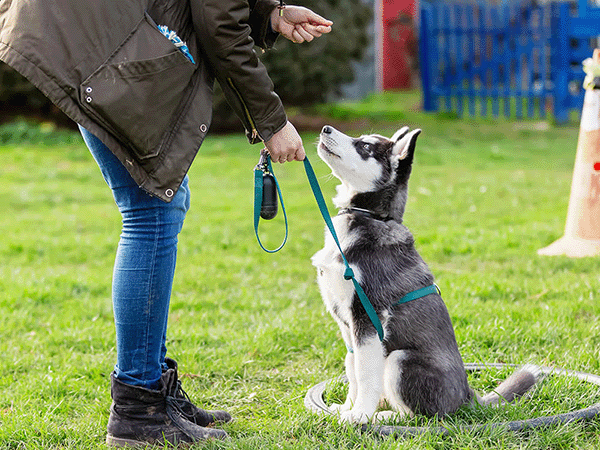Australian Shepherd Facts: Breed Info & Care Guide

Discover the Australian Shepherd, an AKC breed celebrated for its trainable, playful, and affectionate nature. Despite its name, the Australian Shepherd is actually a native breed to the United States, originally developed to breed on farms and ranches. Considered a medium dog, Australian Shepherds were bred for herding beginning in the 1950s. As one of the high-energy breeds, Aussies are known for their boundless energy and need for regular exercise, including aerobic exercise.
In this post, we share insights from almost 10,000 Sniffspot users, offering practical advice for new and prospective Australian Shepherd owners. Whether you're considering owning or rescuing an Australian Shepherd yourself or already have one, you'll find valuable tips on how to care for and enjoy life with this trainable AKC breed. As cold-weather breeds, Aussies are well-suited for various climates and physical activities.
As Sniffspot user Patrick says, "She's my best friend and is so in sync with me. I don't recommend Aussies to beginners, but for people who can handle their exercise needs, intelligence, and attitude, they're amazing. I feel like we communicate effortlessly and she's always there for me."

Source: Sniffspot Community Breed Survey 2024
Australian Shepherd Quick Characteristics
- Breed Type: Herding
- Size: Medium
- Life Expectancy: 12 - 15 years
- Healthy Weight Range: 40 - 65 lbs
- Height Range: 18 -23 in
- Temperament: Trainable, Playful, Affectionate
- Coat Type: Double
- Color: Blue merle, red merle, black, and red
About Australian Shepherds
According to 337 Sniffspot community users who shared real-world data about their Australian Shepherd, we learned these dogs are trainable, playful, and affectionate. The Australian Shepherd is very friendly and social with strangers and very friendly and social with children, making them one of the more dog-friendly breeds. Their coat color can vary widely, including blue merle, red merle, black, and red, often with white markings and black patches.
When living with an Australian Shepherd, 79% of our owners said a large house with a fenced yard is the best environment for Aussies. Additionally, 50% of owners said a rural or suburban area with open spaces is also acceptable. This preference aligns with their history as a breed on farms and their status as one of the active breeds that require ample space for physical exercise and aerobic exercise.
This native breed is highly trainable, learns commands quickly, and responds well to training. Owners also say the Australian Shepherd learns best with positive reinforcement (treats, praise, rewards), consistent daily training routines, and socialization with other dogs and people. Trick training can be an excellent way to engage their intelligent minds and provide necessary brain exercise.
When it comes to exercise, 51% of Sniffspot owners say their Australian Shepherd benefits from moderate amounts of exercise, like regular walks and play sessions. As one of the high-energy breeds, Aussies often require more physical activities than some other dogs, including regular aerobic exercise. The Sniffspot Australian Shepherd community would not recommend this dog breed to first-time dog owners due to their high energy levels and need for experienced handling.
History and Origin of Australian Shepherds
The Australian Shepherd's ancestry is complex, with potential influences from the Carea Leonés, a Spanish sheepdog, and British herding dogs brought to America in the 1800s. While the exact origins are unclear, the breed's development was shaped by the influx of sheep and shepherds during the California Gold Rush and the Civil War. Sheep and herding dogs from both the British Isles and Australia contributed to the breed's formation.
Although the name "Australian Shepherd" emerged from American observations, the breed's genetic roots lie in British herding dogs. A 2017 study confirmed the Australian Shepherd's connection to the UK Rural clade, including Collies and Shetland Sheepdogs, with shared traits like the MDR1 mutation and Collie eye anomaly. Some speculate that German herding dogs and Basque immigrants also played roles in shaping the breed.
Today, the Australian Shepherd remains a popular, versatile breed known for its herding abilities and high energy. Despite its mixed heritage, it has evolved from its origins to become a beloved companion in the U.S.
Australian Shepherd Traits and Characteristics
We compiled Sniffspot community submissions on their own dog breeds to determine these Australian Shepherd dog traits and characteristics:
- Temperament: Trainable, Playful, Affectionate
- Energy Level: High
- Trainability: Highly trainable
- Grooming needs: Moderate maintenance
- Good with Kids: Very friendly and social with children
- Good with Other Pets: Very friendly with other pets
- Height: 18-23 inches tall
Australian Shepherds are known for their distinctive coat colors, including blue merle, red merle, black, and red, often with white markings. These colors are not just for cosmetic reasons; they're part of the breed's charm and heritage.
Unlike barkless breeds, Australian Shepherds can be quite vocal, especially when alerting their owners to potential threats or when engaging in herding behaviors. However, with proper training, their barking can be managed effectively.
What to Expect as an Australian Shepherd Dog Owner
As an Australian Shepherd owner, it's important to know the best dog breed tips as well as expectations from current Australian Shepherd owners. Pet owners should be prepared for a dog that requires regular exercise and mental stimulation on a daily basis. This native breed thrives when given a job to do, which can include activities that mimic their original purpose to breed on farms.

Source: Sniffspot Community Breed Research 2024
Grooming Needs | Moderate Maintenance
Australian Shepherd dogs require moderate maintenance grooming. This means Australian Shepherd owners should expect regular brushing and periodic baths. Australian Shepherd dogs have a double coat, ideal for insulation and protection, especially as cold-weather breeds. Their double coat is considered high shed, producing a significant amount of dead hair.
To keep your Australian Shepherd's coat healthy and up to breed standards, brush their coats regularly to manage shedding and prevent mats. An undercoat rake can be particularly useful during shedding seasons. Of the coat types for common breeds in the herding group, the coat grooming needs for Australian Shepherds are considered moderate maintenance. Frequent grooming is necessary not just for cosmetic reasons, but also for the overall health of your dog.
Exercise Needs | High
Australian Shepherds require high activity levels each day. Though one of the most popular dog breeds, Aussies are considered a very athletic, high-energy breed. As active breeds, they thrive on physical exercise and mental stimulation.
Aussies make great pets for active pat parents, and they thrive with between 1-2 hours of activity each day, including walks and active play sessions. Owners of Aussies report their dogs especially love chasing/playing with a ball or frisbee, playing with squeaky toys, and tug-of-war. These activities not only provide physical exercise but also engage their sharp minds, offering necessary brain exercise.
When medium breeds like Aussies don't get sufficient exercise, they're more likely to act out with undesirable behaviors. They need consistent training, mental activity, and regular aerobic exercise to avoid excess energy and ensure they lead happy lives. Providing alternative behavior options through training can help redirect their energy positively.
Diet and Nutrition
What should you feed your Australian Shepherd to keep him healthy? As a Moderate energy breed, what you feed them is important. A reported 66% of our community feed their Aussie commercial dry kibble.
With moderate exercise, Aussies should eat 2 to 3 cups of vet-recommended food to maintain a healthy weight of around 40 - 65 lbs. However, your Australian Shepherd's ideal weight and food depend on your pet's sex, activity level, and age.
Breed Health Concerns
The Australian Shepherd breed is prone to certain genetic conditions. Hip dysplasia and elbow dysplasia are heritable conditions that pet owners should be aware of. A reported 28% of our Australian Shepherd owners reported digestive issues like constipation, diarrhea, vomiting, and lack of appetite. Aussie's risk for these challenges increase as they age.
Similarly, 22% reported skin conditions like allergies, yeast infections, impetigo, ringworm, alopecia, and folliculitis. Lastly, 20% of Australian Shepherd owners claim their dog struggles with joint problems like arthritis, elbow dysplasia, degenerative issues, and osteosarcoma — common Aussie health concerns.
The Australian Shepherd Health & Genetics Institute is a valuable resource for pat parents looking to understand and manage these breed health concerns. If you're worried about any of these health issues, talk to your Aussie's vet.
How Friendly Are Australian Shepherds?
Another important thing to consider when adopting an Aussie is whether or not they fit with your current family. How friendly are Australian Shepherds compared to other medium-sized breeds?

Source: Sniffspot Community Breed Survey 2024
With consistent training, you can hone your Aussie's herding instinct into a friendly and loyal family dog. Introducing your pet to positive reinforcement (treats, praise, rewards) and consistent daily training routines early helps them avoid undesirable behaviors like overexcitement and herding tendencies. Our community Australian Shepherd owners comment on their pet's friendliness:
"Innate need to herd other animals in the home. They are friendly and loyal to the people they know but do not take well to new people or strangers." (ST)
"He is very reserved and protective of me and my wife + our house. It is difficult to get him acclimated to strangers and other dogs. He is insanely friendly though to his favorite inner circle." (DP)
How to Train an Australian Shepherd
Whether you're adopting an Aussie puppy or a grown Australian Shepherd adult, training is a large part of owning this active breed. When you fail to train your Aussie properly, they're more likely to display undesirable behaviors like overexcitement, excessive herding tendencies, or destructive chewing. Providing stimulating activities and brain exercise is a great first step, but this needs to be paired with the right training for your Aussie.
As a herding breed, Australian Shepherds benefit from praise and positive reinforcement. Here's what our Aussie community recommended based on their experience with their own dog:
- Positive Reinforcement (96%): This includes treats, praise, rewards, and so on for positive behavior.
- Consistent Routines (56%): A consistent training routine allows your pet to get comfortable with expectations.
- Socialization (42%): Socializing your dog with other pets, dogs, and people prepares them to interact with the world.
As dogs bred to breed on farms and for herding, Aussies are considered highly trainable by all types of dog owners. Early socialization and training, starting from 8 weeks of age, can help shape well-behaved adult dogs. Teaching alternative behavior options can be particularly helpful in managing their herding instincts in a home environment.
What Do Owners Love About Australian Shepherds?
We asked Sniffspot Aussie owners what they love the most about their Australian Shepherd pups, and here's what they had to say:
"They're incredibly smart, independent, and so animated and expressive." (Staci)
"Athletic, as long as you’re physically active they’re super fun and friendly dogs. And so soft!" (Leanne)
"They're always up for anything and stick to their person like glue. Very versatile in what you can train them to do." (Liliana)
"I love how versatile my Aussie is. Whether we're out for a hike or practicing agility, she's always up for the challenge. Her coat color changes beautifully with the seasons too!" (Emma)
What Are the Biggest Challenges for Australian Shepherd Owners?
Similarly, Aussie owners shared some of the biggest challenges of living with Australian Shepherds:
"Reactivity - my dog is reactive and when we went to do training, we discovered many of the other dogs there were other herding breeds if not also Aussies. They have such a high drive and are so loyal to their people that they are prone to reactivity, especially if not socialized when they’re young. In addition, she’s mellowed with age, but they are SUPER hyper puppies!" (Patrick)
"While our dog is incredibly clever, she's also independent and difficult to motivate to listen to us. Nothing is as exciting as running off to explore, no matter what kind of food we're holding and trying to tempt her with! She's clever enough to know what she prioritizes." (Staci)
"Sometimes protective as shepherds are bred to be, only at the fence though." (Leanne)
"Managing their high energy levels can be challenging. They need a lot of physical and mental stimulation on a daily basis to stay happy and well-behaved. But with regular exercise and engaging activities, they're a joy to have around." (Michael)
Is an Australian Shepherd Right for a First-Time Dog Owner?

Source: Sniffspot 2024 Community Dog Breed Survey
According to 74% of our Sniffspot community, Australian Shepherds are not a great first-time dog. This comes from their trainable nature and moderate exercise needs. Australian Shepherd owners say it best:
"Too smart for their own good sometimes, sensitive to movement and noise, high herding instinct needs to be met and directed properly" (Joy)
"Highly affectionate, trainable, willing and wanting to learn, incredibly loyal." (Cathleen)
"Their intelligence, loyalty/velcro attachment and energy level can be a lot." (SH)
Advice for Australian Shepherd Owners
Luckily, our Sniffspot community is full of experienced, trustworthy Aussie owners. These Australian Shepherd breed owners share the most essential dog breed tips and advice for prospective or new dog owners:
Be prepared to meet Aussie's high energy level.
"Mental and physical exercise is important, Aussies like to have a job and use their brain." (Emily)
"Do your research! These dogs need mental enrichment, physical exercise, and training DAILY or you will face behavioral issues." (Kirby)
"Trick training is a great way to keep your Aussie mentally stimulated. It taps into their natural instincts and intelligence, and it's a fun bonding activity for both of you." (David)
Give them an outlet for their herding instinct.
"My advice would be to utilize their herding instinct. Allow them to express it! It's amazing to watch their natural instinct and let them do what they were bred to do." (Grace)
"Don't try to get rid of the herding instinct, give them an outlet. For example, buy a herding ball for them to herd instead of letting them herd your smaller pets, you, or children." (Kayla)
Have enough space for them in your home/outside.
"Not a good fit for small spaces if they can't be out and moving or working." (Carrie)
"Don't forget about brain exercise! Puzzle toys, scent work, and obedience training are great ways to keep your Aussie's mind active. It's just as important as physical exercise in preventing undesirable behaviors." (Lisa)
"If you are living in a smaller apartment or urban area, or even a house with a yard be sure to exercise your dog and keep them engaged mentally every day outside of the home and yard. There should be at least one activity a day that will satisfy their need. Whether that be the dog park, agility course, play date, or puzzle." (MF)
Understand their grooming needs.
"Don't underestimate the importance of regular grooming. An undercoat rake is a must-have tool, especially during shedding seasons. It's not just about keeping them looking good; it's essential for their skin health too." (Sarah)
Frequently Asked Questions about the Australian Shepherd
What is the average lifespan of an Australian Shepherd?
The average lifespan of an Australian Shepherd is typically between 12 - 15 years.
What is the size of an Australian Shepherd?
An adult Australian Shepherd weighs between 40 - 65 lbs and stands between 18 - 23 inches tall at the shoulder.
How much grooming does an Australian Shepherd need?
Australian Shepherd dogs require moderate maintenance grooming. This means Australian Shepherd owners should expect regular brushing and periodic baths. Australian Shepherd dogs have a double coat, ideal for insulation and protection. Their double coat is considered high shed.
To keep your Australian Shepherd's coat healthy and up to breed standards, brush them regularly to manage shedding and prevent mats. Of the coat types for herding breeds, the coat grooming needs for Australian Shepherds is about average.
How much exercise does an Australian Shepherd need?
As one of the high-energy breeds, Australian Shepherds require substantial activity each day. Aussies are considered a highly athletic, high-energy breed that thrives on regular exercise.
Aussies make great pets for active pat parents, and they flourish with between 1-2 hours of physical exercise each day, including walks and active play sessions. Owners of Aussies report their dogs especially love chasing/playing with a ball or frisbee, playing with squeaky toys, and tug-of-war.
When active breeds like Aussies don't receive enough exercise, they may develop unwanted behaviors. These dogs need ongoing training, mental stimulation, and consistent physical activity to channel their energy effectively and lead happy lives.
How friendly are Australian Shepherds with children?
According to our data, Australian Shepherds are very friendly and social with children.
How well do Australian Shepherds get along with other pets?
Our research shows that Australian Shepherds are very friendly with other pets with other pets.
What should you feed your Australian Shepherd to keep him healthy?
As a moderate energy breed, what you feed your Aussie is important. A reported 66% of our community feed their Aussie commercial dry kibble.
With moderate exercise, Aussies should eat 2 to 3 cups of vet-recommended food to maintain a healthy weight of around 40 - 65 lbs. However, your Australian Shepherd's ideal weight and food depend on your pet's sex, activity level, and age.
What health concerns are common for Australian Shepherds?
The Australian Shepherd breed is most prone to digestive issues like constipation, diarrhea, vomiting, and lack of appetite and skin conditions like allergies, yeast infections, impetigo, ringworm, alopecia, and folliculitis.
Are Australian Shepherds good for cold weather?
Yes, Australian Shepherds are considered cold-weather breeds. Their double coat provides excellent insulation against cold temperatures, making them well-suited for chilly climates. However, as with all dogs, they should still be protected from extreme weather conditions. Their status as cold-weather breeds also means they may struggle in very hot climates and require extra care during the summer months.
Are Australian Shepherds considered barkless breeds?
No, Australian Shepherds are not considered barkless breeds. In fact, they can be quite vocal, especially when alerting their owners to potential threats or when engaging in herding behaviors. However, with proper training and by providing alternative behavior options, their barking can be managed effectively. As with many dog-friendly breeds, early socialization and consistent training are key to developing good manners.
Resources for Australian Shepherd Owners
Whether you're a current Australian Shepherd dog owner or you're considering adopting an Aussie, Sniffspot is here to lend a helping hand. Here are some of the most relevant resources for Australian Shepherd owners:
- Australian Shepherd Club of America (one of the primary breed clubs for Aussies)
- Most Popular Australian Shepherd Dog Names
- Best Australian Shepherd Dog Rescues and Shelters
Remember, while Aussies are generally healthy dogs, regular check-ups with your veterinarian are essential to catch and address any potential genetic conditions early. With proper care, exercise, and love, your Australian Shepherd can be a joyful and loyal companion for many years to come.
Sources:
Most recent articles
Related articles
Top dog guides per area
Dog training guides

Dog Food Aggression: Why You Shouldn't Punish It
Does your dog ever growl when you walk by their food dish? Maybe they get possessive of treats, carrying them far away and giving you side-eye when you start to approach — or snarling at your other pets or children if they get too close.

Best Dog Fields in the US: 25+ Wide-Open Spaces for Your Pup to Run Free
The best dog fields in the US offer something that traditional enclosed parks simply can't match: acres of open space where your pup can truly stretch their legs and run at full speed. From Colorado's 470-acre prairie meadows to Tennessee's award-winning "Outback," these wide-open spaces allow dogs to roam, explore, and exercise naturally while engaging instincts that cramped urban parks suppress.

The Ultimate Guide to Scent Training for Dogs
Your dog's nose is an amazing tool. Did you know they have 40 times the olfactory receptors than humans? Scent training for dogs taps into this superpower, turning everyday moments into exciting sniff-fests. It's enriching for all types of dogs – reactive, shy, or simply adventurous. Ready to explore the world of scent work for dogs? Let's get started.

Service Dog Training Costs: DIY vs. Pro
More than 80 million Americans rely on their service dogs to help them navigate the world. Task-trained assistance animals perform a huge range of life-changing—in many cases, life-saving—services: These dogs act as eyes for visually impaired handlers, provide mobility support, alert to seizures and blood sugar crashes, interrupt anxiety attacks, remind their people to take medications, and so much more.

How to Deal With Puppy Potty Training Regression
You thought those dreaded middle-of-the-night potty breaks were over. You were finally free from cleaning up puppy puddles. Then, suddenly, your furry friend starts having accidents again. It's frustrating, right? This puppy potty training regression is more common than you think. Don't worry; we'll help you get your pup back on track. We'll cover the common causes, offer practical solutions, and give you actionable steps to tackle this challenge together.

Dirty Dog Syndrome: Causes, Solutions, and Prevention
It's a cringe-worthy moment every dog owner dreads: your furry friend chowing down on something truly disgusting. If your dog has a penchant for poop, you're dealing with coprophagia. It's more common than you think, and thankfully, often manageable. This article explores the reasons behind dirty dog syndrome, from instinct to learned behavior. We'll also give you practical tips to help break this unpleasant habit.

How to Train Your Rescue Dog: A Complete Guide
* All Sniffspot articles are reviewed by certified trainers for quality, please see bottom of article for details *
Dog enrichment guides

Best Dog Water Parks in the US: 15+ Amazing Splash Destinations for Your Pup
Do you have a water-loving dog looking to burn some energy? There are countless dog parks to visit throughout our country — but some of them become far too hot in the midday sun to be safe for your pets to play. That’s why we’ve put together a list of some of the best dog water parks throughout the United States! At these locations, your pup can frolic, splash, and swim to their heart’s content.

Best Dog Fields in the US: 25+ Wide-Open Spaces for Your Pup to Run Free
The best dog fields in the US offer something that traditional enclosed parks simply can't match: acres of open space where your pup can truly stretch their legs and run at full speed. From Colorado's 470-acre prairie meadows to Tennessee's award-winning "Outback," these wide-open spaces allow dogs to roam, explore, and exercise naturally while engaging instincts that cramped urban parks suppress.

Best Toys for Herding Dogs: Keeping Your Pup Happy & Engaged
Herding dogs are amazing, intelligent companions. But that also means they need more than just a simple game of fetch. Finding the right toys for herding dogs is key to keeping them happy and stimulated. This article explores some of the best toys for herding dogs, including options specifically for breeds like Border Collies and Australian Shepherds. We'll help you discover the perfect herding toys for dogs to tap into their natural instincts and keep them entertained for hours.

Tough Dog Toys for Aggressive Chewers: A Practical Guide
Does your dog destroy every toy you give them? Is your house littered with the remnants of plush toys? Are you tired of wasting money on "indestructible" dog toys for aggressive chewers that don't last? Then this post is for you. We'll cover everything you need to know about finding the best dog toys for aggressive chewers, so you can finally give your pup something safe, durable, and fun.

Daily Exercise Calculator: How Much Exercise Does Your Dog Need?
Everyone knows dogs need exercise, but how much is enough? Walks are great, but creating a truly balanced fitness plan means understanding your dog's specific needs. This post helps you develop a daily exercise calculator for your dog, considering breed, age, and lifestyle. We'll cover fun activities, understanding exercise intensity, and recognizing when your pup has had enough. Let's create a plan that keeps your dog happy and healthy!

Complete Guide To Herding With Dogs
* All Sniffspot articles are reviewed by certified trainers for quality, please see bottom of article for details *

Dog Enrichment Activities: The Ultimate Guide
Ever feel like your dog is restless or bored? They may be getting enough exercise, but still need more. That's where enrichment activities for dogs come in. Giving your dog opportunities to sniff, explore, and problem-solve can make a world of difference. Whether you have a puppy, adult, or senior dog, enriching their environment is key for their well-being. Let's explore how to add cognitive enrichment for dogs, even tailoring activities to your dog's breed with breed specific enrichment and fun enrichment games for dogs.
Dog reactivity guides

Rottweiler Aggression: Truth vs. Myth
Many dogs have gotten a bad reputation over the years for being "dangerous breeds." Rottweilers are among them. Like pit bulls and other large, blocky-headed types of dogs, these powerful and beautiful animals are often assumed to be aggressive.

Best Dog Fields in the US: 25+ Wide-Open Spaces for Your Pup to Run Free
The best dog fields in the US offer something that traditional enclosed parks simply can't match: acres of open space where your pup can truly stretch their legs and run at full speed. From Colorado's 470-acre prairie meadows to Tennessee's award-winning "Outback," these wide-open spaces allow dogs to roam, explore, and exercise naturally while engaging instincts that cramped urban parks suppress.

What Is a Reactive Dog? A Practical Guide for Owners
Does your dog suddenly transform into a barking, lunging Tasmanian devil on walks? It's stressful for both of you. If this sounds familiar, you might have a reactive dog. Understanding what is a reactive dog is the first step to calmer walks. We'll explore the common triggers and give you actionable strategies to manage and modify this behavior. Let's turn those stressful walks into enjoyable outings.

How to Socialize a Reactive Dog: A Step-by-Step Guide
Does your dog display reactivity to other pets or people? Maybe they’re a new rescue pup and are still settling into your home. Or they were sick growing up, so you missed their critical socialization period. Possibly they’ve had a bad experience after being raised as a normal puppy.

What Is a Reactive Dog? A Complete Guide
Is your dog overly excited or fearful around other dogs? Do they bark, lunge, or whine? You might have a reactive dog. Many dog owners face this challenge. Understanding what a reactive dog is is the first step to helping them. This guide explores the common causes of dog reactivity, explains what makes a dog reactive, and offers practical tips and resources. Let's work together to build a stronger bond with your dog and enjoy stress-free walks.

9 Best Online Communities for Reactive Dog Parents
Does your dog's reactivity make walks stressful? You're not alone. Many dog owners face similar challenges. This guide offers practical advice and support for managing reactivity, including finding the best online dog training for reactive dogs. We'll connect you with reactive dog support groups, share training tips, and explore resources like the best dog training app for reactive dogs. Let's build a stronger bond with your dog, together.
* All Sniffspot articles are reviewed by certified trainers for quality, please see bottom of article for details *
How To Groom a Reactive Dog
* All Sniffspot articles are reviewed by certified trainers for quality, please see bottom of article for details *
Sniffspot community guides

The State of Public Dog Parks Across the United States
From 2009 to 2020, there was a 40 percent increase in the development of public dog parks. Designated spots for canine exercise have become commonplace in every major city in North America — many pet owners won’t even consider renting an apartment that doesn’t have its own fenced-in pet area for their canine companions.

Best Dog Fields in the US: 25+ Wide-Open Spaces for Your Pup to Run Free
The best dog fields in the US offer something that traditional enclosed parks simply can't match: acres of open space where your pup can truly stretch their legs and run at full speed. From Colorado's 470-acre prairie meadows to Tennessee's award-winning "Outback," these wide-open spaces allow dogs to roam, explore, and exercise naturally while engaging instincts that cramped urban parks suppress.

How This Family is Affording Their Dream Property Through Renting it Hourly to Dogs
Thousand Oaks, California has been a safe haven for Sniffspot host, Jen, since childhood. Having grown up in busy Santa Barbara, Jen, an introvert from an early age, would seek out solitude and serenity away from tourists attractions and droves of people visiting from elsewhere. “My grandparents own 60 acres about a 30 minute drive from here, and I grew up spending every summer and every holiday visiting them on the ranch,” Jen explained. “In Santa Barbara, we wouldn't go to the beach on the weekend because that's where everybody was, so you'd find places off the beaten path where the tourists weren't. For me, the ranch was just my happy place.”

Host Tips: Ellen K. What Makes Sniffspot Successful for Me
Ellen is the host of Country Pasture Getaway, one of Sniffspot's most popular sniff spots. She has taken the time to write up the lessons she has learned about how to be a great sniff spot host.

How this Oregon Farmer is Making a Business From Renting Her Land to Dogs
Just 20 minutes outside of the busy city of Portland, Oregon, and settled right on the banks of the Columbia River, you’ll find what countless visitors have flocked to the area in search of – mountain views, crisp, clean air, and running water for miles. What you might not expect to find, however, is a hidden oasis designed just for dogs and their people, owned and operated by a farming couple and enjoyed by visitors on two legs, and four.

Host Tips: Fran T. Providing Great Guest Service at our Spot
Fran is the host of Ranch Setting, one of Sniffspot's most popular spots. She has taken the time to write up the lessons she has learned about how to be a great Sniffspot host.

How Sniffspot Helped a Nervous Rescue Work Through His Fears and Change His Family’s Life
This is the story of a family and dog rescuing each other.
Top dog trainers in the US

The Best Dog Trainers in the United States of 2025
This is a list of the top dog trainers in the United States, based on votes from the Sniffspot community and the general public.
The Best Dog Trainers in Seattle, WA of 2025
This is a list of the top dog trainers in Seattle, WA, based on votes from the Sniffspot community and the general public.
The Best Dog Trainers in Portland, OR of 2025
This is a list of the top dog trainers in Portland, OR, based on votes from the Sniffspot community and the general public.
The Best Dog Trainers in Los Angeles, CA of 2025
This is a list of the top dog trainers in Los Angeles, CA, based on votes from the Sniffspot community and the general public.
The Best Dog Trainers in New York, NY of 2025
This is a list of the top dog trainers in New York, NY, based on votes from the Sniffspot community and the general public.
City dog parks guides

Top 10 Indoor Dog Parks: A US Guide
Looking for a space to play with your dog no matter what the weather’s like outside? Look no further than our list of the best indoor dog parks in the United States! These climate-controlled spaces are growing in popularity as pet ownership increases throughout the country. As a bonus, many of them also offer dog training, boarding, grooming, or daycare services on the premises.

Best Dog Fields in the US: 25+ Wide-Open Spaces for Your Pup to Run Free
The best dog fields in the US offer something that traditional enclosed parks simply can't match: acres of open space where your pup can truly stretch their legs and run at full speed. From Colorado's 470-acre prairie meadows to Tennessee's award-winning "Outback," these wide-open spaces allow dogs to roam, explore, and exercise naturally while engaging instincts that cramped urban parks suppress.

Best Dog Parks in the US: Ultimate Guide to Public & Private Off-Leash Adventures
Is your pup giving you those pleading "let me run free" eyes? Whether you're a new dog parent or a seasoned pro looking for fresh adventures, finding the perfect off-leash paradise for your furry friend can feel ruff! From sun-soaked California beaches where your water-loving lab can make a splash to mountain trails in Vermont where your adventure buddy can chase every scent, we've sniffed out the 15 best dog parks across America.

Dog Parks Near Me: Las Vegas Edition
Looking for the perfect dog park near me in Las Vegas? You're in luck! This guide explores all the best options for your pup, from public dog parks to private dog parks near me on Sniffspot. We'll help you find the ideal spot for playtime, socializing, and fresh air. Plus, we'll cover essential etiquette and safety tips to ensure a happy visit for everyone. Get ready for some tail-wagging fun!

Top Sniffspot Locations: Find the Perfect Dog Park
Looking for the perfect dog park? Whether you need a wide-open public space or a private, fenced-in spot, this guide will help you find the best dog parks across the US. We'll cover top-rated public parks, the perks of private dog parks, and even explore Sniffspot locations – giving your pup a safe and fun place to play. Ready to find your dog's new favorite spot? Let's go!

Sniffspot: Portland's Best Private Dog Parks
Ready to discover Portland's best dog parks? Whether you're looking for a public park or the unique experience of a private Sniffspot, this guide has you covered. We'll help you find the perfect spot for your pup, with tips on what to bring, how to prepare, and even understanding dog body language. Plus, we'll explore some top Portland dog parks, including public and Sniffspot options, so you can plan your next dog-friendly adventure in the City of Roses.
Portland Dog Parks: Public & Private Options
This page is about public city dog parks and also includes Sniffspot private dog parks. Sniffspot is the largest network of private dog parks for rent in the world!
Small Dog Park Guide: Tips for Finding the Perfect Spot
Finding the perfect dog park for your small breed can be ruff! Big dog parks can be overwhelming, even dangerous, for little pups. This comprehensive guide helps you sniff out the best small dog parks for your pint-sized companion, covering everything from essential safety checklists to top recommendations for small dog parks across the US—including both public spots and private dog parks.
Dogs breeds

German Shepherd Dogs: Insights From Real Dog Owners
The German Shepherd Dog (GSDs) are known for their intelligence, loyalty, and striking appearance. They're also incredibly versatile, excelling as working dogs and devoted family companions. This guide covers everything you need to know about GSDs, from understanding their unique traits and rich history to practical advice on training and care. So, whether you're a seasoned GSD owner or just starting your research, let's explore this remarkable breed together.

Best Dog Fields in the US: 25+ Wide-Open Spaces for Your Pup to Run Free
The best dog fields in the US offer something that traditional enclosed parks simply can't match: acres of open space where your pup can truly stretch their legs and run at full speed. From Colorado's 470-acre prairie meadows to Tennessee's award-winning "Outback," these wide-open spaces allow dogs to roam, explore, and exercise naturally while engaging instincts that cramped urban parks suppress.

Labrador Retriever: Ultimate Guide by Owners
Discover the Labrador Retriever, a breed celebrated for its playful nature, affectionate temperament, and trainability. Labradors are known for their friendly demeanor and adaptability, making them perfect family companions and versatile working dogs. As one of the most popular types of retrievers, Labs are ideal companions for various lifestyles and are recognized by the American Kennel Club (AKC) as an excellent breed for families.

Golden Retriever Advice: The Complete Owner's Guide
Golden Retrievers: they're gorgeous, playful, and incredibly popular. But before you welcome one into your home, you need the right golden retriever advice. This guide draws on the wisdom of nearly 10,000 Golden Retriever owners, offering practical tips for caring for these affectionate dogs. From understanding their high energy levels to mastering grooming and training, we'll cover everything you need to know. So whether you're already a devoted Golden parent or just starting your research, get ready to learn how to give your furry friend the best possible care.

American Staffordshire Terrier: Your Complete Guide
Think American Staffordshire Terriers are tough? Think again. While their muscular build might intimidate some, these dogs are known for their playful and loyal personalities. This guide draws on the experience of nearly 10,000 AmStaff owners to reveal the truth about this often misunderstood breed. Want to learn more about caring for an American Staffordshire Terrier? You're in the right place.

Australian Shepherd Facts: Breed Info & Care Guide
Discover the Australian Shepherd, an AKC breed celebrated for its trainable, playful, and affectionate nature. Despite its name, the Australian Shepherd is actually a native breed to the United States, originally developed to breed on farms and ranches. Considered a medium dog, Australian Shepherds were bred for herding beginning in the 1950s. As one of the high-energy breeds, Aussies are known for their boundless energy and need for regular exercise, including aerobic exercise.

Essential Husky Facts for Owners: Breed Guide
Discover the Siberian Husky, a breed celebrated for its curious, intelligent, and loyal nature. Considered a medium-sized dog, Siberian Huskies were originally bred in Russia for sledding, beginning in the early 20th Century. Today, they're one of the most popular active breeds in North America.




























